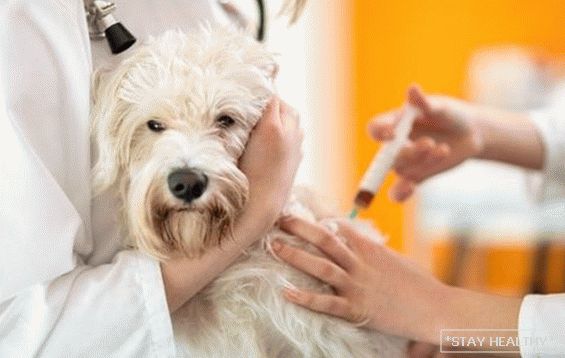 Пн, 07 май 2018 Автор: Елена Витинг
Пн, 07 май 2018 Автор: Елена Витинг
Diabetes in dogs is an endocrine disease,
provoked by changes in the functioning of the pancreas,
the consequence of which is a violation of metabolic processes and
reducing the level of the hormone insulin. Mostly afflicted suffer
middle age dogs (from 6 to 9 years old). Bitches are more prone
disease than males.
Contents
Causes and types of diabetes in dogs
Risk factors for disease include:
• obesity;
• chronic pancreatitis;
• stress;
• hypodynamia;
• hormonal disorders;
• heredity.
Like humans, dogs have two types of illness: I
(insulin-dependent) and II (insulin-independent). Both kinds
characterized by insulin deficiency, but in the first case
it is absolute, and in the second, relative.
Type I diabetes in dogs
Pancreas no longer secretes enough
insulin – a protein hormone that is responsible for controlling glucose
and cellular energy supply. Pancreatic Inability
producing insulin leads to an increase in the sugar content that
has a devastating effect on the digestive tract, nervous and
circulatory system. The causes of the disease are most often associated with
autoimmune lesions and genetic predisposition.
Type II diabetes in dogs
The disease is characterized by gradual development and less
severe symptoms. Pancreas produces insulin in
sufficient or slightly reduced quantity, but at the same time
body cells do not perceive the hormone. With inadequate or
late treatment of the disease can degenerate into diabetes i
type, and also cause hypertension, vascular lesions,
trophic ulcers and gangrene.
Symptoms of diabetes in dogs
Early detection of the disease is one of the main causes.
successful treatment. Owners must be very attentive to
changes in the behavior and condition of the four-legged friend.
The following are indicative of diabetes in dogs.
clinical manifestations:
• Light urine, abundant and frequent urination: molecules
glucose is excreted fluid. Water loss can lead to
deficiency of potassium and sodium – electrolytes that regulate tone
vessels.
• Dehydration and intense endless thirst: the animal tries
compensate for fluid loss by increasing water intake.
• Visual impairment, cataract, lens opacity: increased
sugar levels damage the blood vessels of the retina.
• Increased food intake, accompanied by weight loss:
glucose no longer enters the cells in the right amount, level
carbohydrate is dramatically reduced. As a result, the energy source
become muscle and fatty layer, which leads to exhaustion.
• The smell of acetone from the mouth.
• Flaccidity, apathy, depression.
• A marked increase in liver palpation.
• Gastrointestinal disorders: abdominal pain, vomiting, diarrhea.
• Skin pathology, hair loss.
In rare cases, the animal has tachycardia, weakness.
hind limbs and poor wound healing. If you suspect
For your dog’s diabetes, contact your veterinarian as soon as possible.
Remember that a strong decrease or, conversely, an increase in the content
blood sugar can lead to diabetic coma.
Establishing the diagnosis and treatment of diabetes in dogs
If you suspect a lack of insulin secretion, veterinarians
carry out a set of activities aimed at precise
diagnosis: visual and tactile inspection of the animal, general and
biochemical blood test, hemoglobin monitoring and concentration
glucose, the study of hormonal levels and urine. If you suspect
pathology is necessary ECG and ultrasound of the digestive tract.
Treatment of the disease involves the relief of symptoms,
achieving stable glucose levels and degradation prevention.
In order to normalize the sugar content, it is practiced
insulin therapy, the frequency of which is determined by the attending physician.
Dogs get pork insulin with prolonged
action.
To regulate the water balance of the animal are shown
vitamin-mineral complexes, pituirin injections (intramuscularly) and
instilling into the nasal passages of adiurekrin. Remember that diabetes is not
sentence, with timely and proper treatment can be minimized
reduce insulin injections and achieve sustained remission.
Dog’s diet
A diabetic pet needs a carefully selected
fractional diet. Feed the dog must be the same small
portions at the same time up to six times a day. To quench
thirsty well alkaline mineral water. Veterinarians
recommend supplementing nutrition with L-carnitine, selenium, zinc,
magnesium, vitamins A, B6, B12, E. These elements are responsible for
improved insulin cell susceptibility and stimulation of digestion
glucose.
Dog food-diabetic is characterized by an increased content
proteins and fiber. Low Fat Fermented Milk Allowed
products, dietary meats (turkey, veal, beef,
rabbit meat), boiled egg white, steam omelette, cabbage, pumpkin,
Jerusalem artichoke, zucchini.
From the diet should be completely eliminated sugar and flour
products, corn and wheat flour, oatmeal, canned food,
spices, cream, fatty meat and fish, white rice, vegetables and fruits,
containing a large percentage of fast carbs: onions, beans, carrots,
beets, potatoes, garlic.
Preventive measures
Since 80% of cases of diabetes in dogs is hereditary
disease, talking about disease prevention is not necessary. but
owners can reduce the risk of pathology, if
adhere to the following recommendations:
• Control the food of the animal, avoid overfeeding.
Eliminate fatty, sweet, flour, spicy, smoked and fried
the dishes. A balanced menu should include complex carbohydrates,
fiber and high-quality proteins.
• Provide your pet with a lively lifestyle. Physical
exercise, long walks and games prevent
overweight. Avoid stress.
• Sokam, prone to diabetes, shown sterilization.
Regularly bring the dog to the vet for preventive
surveys and analyzes if it is genetically predisposed to
disease or belongs to the breeds most often suffering
diabetes: Labrador, dachshund, Pomeranian, pug, Doberman,
dwarf poodle, beagle.






